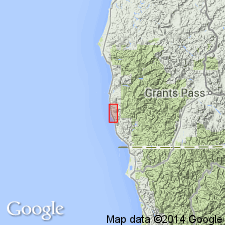
- Usage in publication:
-
- Houstenaden Creek Formation
- Modifications:
-
- Named
- Biostratigraphic dating
- Dominant lithology:
-
- Sandstone
- AAPG geologic province:
-
- Klamath Mountains province
Summary:
Named for exposures near mouth of Houstenaden Creek (about 7 mi. north of Cape Ferrelo), Cape Ferrelo 15' quad., Curry Co., OR. Type area is entire mapped (outcrop) area (near Cape Sebastian, Mach Point, and Houstenaden Creek). Rocks previously assigned to Cape Sebastian Sandstone by Dott (1973) later excluded and called "lower sequence" by Bourgeois (1980, 1983). Consists primarily of turbidites, amalgamated sandstone, and channelized conglomerate. Is at least 500 m thick (composite section based on all accessible sections) [about 10 m thick below type section of Cape Sebastian Sandstone, north side of Salal Cove]. Overlies, with presumable fault contact, Late Jurassic Otter Point complex; underlies, with angular unconformity, restricted Cape Sebastian Sandstone. Deposited in basin plain to submarine channel system. Age is Campanian (Late Cretaceous) based on dinoflagellates and angiosperm pollen; possibly Albian (for lowermost shales) based on poorly preserved palynomorphs and foraminifers.
Source: GNU records (USGS DDS-6; Menlo GNULEX).
For more information, please contact Nancy Stamm, Geologic Names Committee Secretary.
Asterisk (*) indicates published by U.S. Geological Survey authors.
"No current usage" (†) implies that a name has been abandoned or has fallen into disuse. Former usage and, if known, replacement name given in parentheses ( ).
Slash (/) indicates name conflicts with nomenclatural guidelines (CSN, 1933; ACSN, 1961, 1970; NACSN, 1983, 2005, 2021). May be explained within brackets ([ ]).

